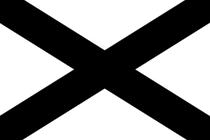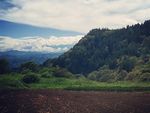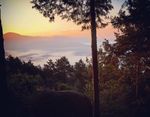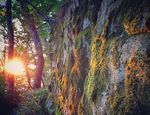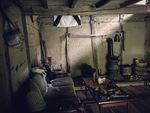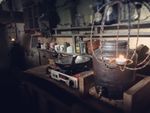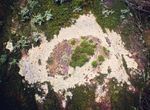Woodland Patchwork
Woodland Patchwork | |
|---|---|
|
Flag | |
| Motto: From the woodland, Freedom | |
 Woodland Patchwork within Japan - Territory marked in Red, Orange and Yellow | |
| Capital | Yakozue |
| Official languages | English, Japanese, German, Woodlandic (de facto, unofficial) |
| Demonym(s) | Woodlander |
| Government | Tribal Council |
• Founder | Again Wilder |
| Establishment | 23 October 2013 |
| Population | |
• Census | 39 |
| Currency | Bitcoin |
| Time zone | WST |
Woodland Patchwork is a micronation on the Japanese archipelago. It identifies itself as a "sovereign, independent micronation", a "nature-based solutions micronation" and as an "old-fashioned living micronation". It is an enclave and exclave micronation, consisting of multiple non-contiguous patches of land covering an area of 10.2 million acres. Its first established hamlet, Yakozue, is located high in the mountains East of the Hida Range.
History, foundation and territory
Initial Territory Acquisition
Founded on the Japanese archipelago, Woodland Patchwork declared independence from Japan on 23 October 2013. This occurred after the founder, Again Wilder, also known as Hideyuki Yoshida, had laid legal claim for a twenty year period to 2.5 million acres of abandoned woodlands via Japanese acquisitive prescription, which is the Japanese equivalent of common law adverse possession. Wilder then acquired legal ownership by self-prescription and proclaimed the land a new micronation, founding Woodland Patchwork.
2018 Winter Solstice Territory Acquisition
On 21 December 2018, Woodland Patchwork acquired a further 7.7 million acres of abandoned woodland bringing the total micronational area to 10.2 million acres, or 41,440 km2, a jurisdiction equivalent to the size of Japan's southwestern island of Kyushu, which is roughly 11% the size of Japan.
Recognition
There has been no diplomatic recognition of Woodland Patchwork by Japan or any other member of the United Nations.
Media
In 2014 somebody at r/TodayILearned linked to Woodland Patchwork's MicroWiki page. The entire MicroWiki website subsequently became temporarily unavailable due to slashdot effect.
We're hosted on a single VPS with 1&1 internet - 3GHz CPU and 2GB of RAM. I guessed something was up when I noticed abnormal CPU load and within a few minutes, well, everything crashed. We've apparently received Reddit's famous "Hug of Death"... Glad to see that people find our site of interest - I never expected we'd end up on the front page of TIL.
— Petya d'Égtavie, MicroWiki webmaster (2010-2014)
As the online bitcoin community became aware that Woodland Patchwork was the first micronation ever to adopt bitcoin as its official micronational currency, the news of Woodland Patchwork's foundation went viral. Yahoo, El Confidencial and RT were the biggest online outfits to publish the news. Bitcoin enthusiasts around the world speculated that Satoshi Nakamoto was behind the founding of Woodland Patchwork. In 2015 Condé Nast Traveller magazine listed Woodland Patchwork as one of the smallest and most extravagant nations in the world. In 2018 the website The Culture Trip listed Woodland Patchwork as one of the 10 most obscure countries on the planet.
Geography and climate
Because of the mountainous topography of Woodland Patchwork, a large part of it is covered with beautiful primary and secondary forests, colorful alpine flowers, and long river valleys. Forest areas cover roughly 80% of the total land area and agricultural lands cover 20%.
The highest point of Woodland Patchwork is located in Raidön Territory, with an elevation of 1,378 meters (4,520 feet) above sea level, and the lowest point is located in Nanzan Territory, with an elevation of 0 meters (0 feet) above sea level.
The weather and climate, as well as the plant and animal life distributed in Woodland Patchwork, are greatly affected by the surrounding sea. Due to abundant rainfall and a mild maritime climate, a wealth of flora and fauna grow throughout the micronation.
-
Yakozue and its environs East of the Hida Range
-
Goat-antelope of Woodland Patchwork
-
Hand-tilled fields in Kasagi Territory
-
Raidön Territory at Dawn
-
Summer Sunrise in Kasagi Territory
Politics
Government
Woodland Patchwork is governed by a Tribal Council. Currently seven Tribes of seven Territories have formal tribe-to-tribe relationships with one another, and as a whole make up Woodland Patchwork. Four of the tribes are located on Honshū, one tribe on Shikoku, one tribe on Hokkaidō, and one tribe on Yakushima. In total, the Tribal Council exercise jurisdiction over an area roughly the size of Kyushu. The designated capital of Woodland Patchwork is located in Raidön Territory at Yakozue Hamlet, where the Raidön Tribe hosts meetings and shindigs.
Tribes and Territories
- Raidön Tribe and Territory (らいどん)
- Chikuma Tribe and Territory (ちくま)
- Anpachi Tribe and Territory (あんぱち)
- Katchan Tribe and Territory (かっちゃん)
- Sen Tribe and Territory (せん)
- Kasagi Tribe and Territory (かさぎ)
- Nanzan Tribe and Territory (なんざん)
Manifesto
In late 2014 the founder of Woodland Patchwork revealed a manifesto online in a r/IAmA post.
1. Woodland Patchwork shows that a secession is possible right now – physically, politically, financially or otherwise. 2. Woodland Patchwork is a vehicle to raise awareness about bitcoin, a cryptocurrency that presents a real chance at financial freedom from corrupt establishment(s). 3. Woodland Patchwork represents a time-honored idea (micro-nation) and a timely idea (crypto-currency), that together can stand tall on the shoulders of giants. 4. Woodland Patchwork is proof-positive that we can use the current systems’ laws and by-laws as leverage against the status quo. 5. Woodland Patchwork is neither protest nor disobedience, it is proactive, solvent and righteous. It is Freedom !
— Again Wilder
Demographics
Population
|
50% of the Woodland Patchwork population consists of people of Norse descent and the other 50% percent are Japanese people. As of 2019, there are twenty-three full time residents and sixteen honorary citizens who live abroad.
Language
Woodlanders speak a mix of English, Japanese, German and Woodlandic. English and Japanese are generally the only languages used for official government business, although some Woodlandic is used for ceremonial occasions.
Culture
Flag
The Woodland Patchwork flag consists of a black saltire on a white background. The white represents peace, and the black represents freedom, with the saltire patching them both together.
Religion
Woodland Patchwork faith is a blend of Animism and Totemism.
Old-fashioned living
Woodland Patchwork is largely self-sufficient and lives mostly off the land, with an emphasis on “old time” or “lost” skills that were used by previous generations, especially from those of whom subsisted in Japan, The Carolinas and Northern Europe. Woodland Patchwork grows and scavenges a majority of its food, practices seed saving, food preservation and general frugality. Wooodland Patchwork lives largely without electricity, except for its bitcoin mining operations; uses hand operated well pumps, coffea grinders, rice threshers, etc; and utilizes natural slope and roof-tops for engineering gravity fed water systems.
Though Woodland Patchwork is mostly old-fashioned in thinking and living, most Territories are accessible by road and many Woodlanders utilize those roads for traveling into the lowlands.
Satoyama 3.0
Woodland Patchwork employs a system called Satoyama 3.0, which is a type of sustainable and stable living design, or nature-based solutions design, that includes regenerative programs such as revitalizing time-honored infrastructure, planting food bearing trees and other perennials, practicing bushcraft, and in general being good stewards of the landbase. The system shares borders and mores with both the traditional Japanese Satoyama and the Wilderness.
-
Raidön Tribe member - Again Wilder
-
Yakozue Main Hut (Elev 3,608 ft), Raidön Territory
-
Yakozue Main Hut Kitchenette
-
Observing the Return of the Sun on Winter Solstice
-
Ancient Herd location marker
